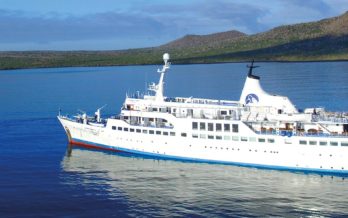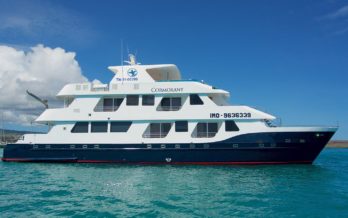Cruise Overview
The San José is 16-passenger yacht, designed for navigation in the Galapagos Archipelago. The yacht was carefully planned and built during 2004 in Guayaquil, Ecuador with the comfort of her guests in mind. Each of the eight double cabins has full air conditioning, a private bathroom, and is incredibly spacious. Additionally, the engine room is located below the living and dining room, to ensure minimal disturbance from engine noise during navigation.
The social areas include a lovely dining room, lounge, bar, TV, DVD, and a small library. The San José also offers plenty of outside areas to relax and enjoy the natural sceneries of the Galapagos Islands. There are various carpeted deck areas with reclining chairs and an outdoor bar. On the top deck, there is a sun deck which is great for relaxation and panoramic views.
Cabins & Social Areas
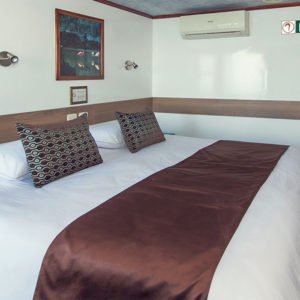
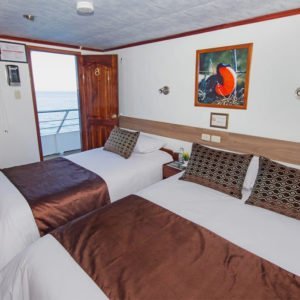
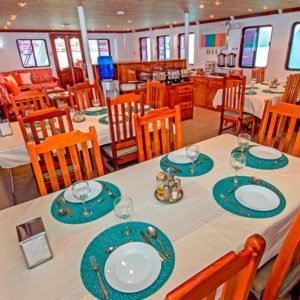
Eastern Islands
Departs Tuesdays
Upon arrival at Baltra Airport, you will first pass through an airport inspection point where your TCT (Transit Control Card) will be checked and stamped (please keep this carefully with your passport as you will need to show it again when you leave Galapagos). Here you will also pay the Galapagos National Park entrance fee of USD 100 (unless it has been prepaid). To ensure that no foreign plants or animals are introduced to the islands, your luggage will be inspected as well. At the arrival hall a naturalist guide will meet you and escort you on a short bus ride to the harbor at Baltra. By dinghy you will be taken to the yacht.
Afternoon Excursion: Mosquera
Mosquera Islet is located between Baltra and North Seymour. This is a small islet formed by a geological uplift, with a reef of rocks and coral and a great white sand beach, where a population of sea lions can be found. You can also observe several species of shorebirds. Along the rocks are commonly running Red Lava crabs or Sally light-foot crabs.
Morning Excursion: Darwin Bay (Genovesa)
This bay has origin when the crater of this island collapsed below sea level. The wet landing is on a beautiful white coral sandy beach. This is a favorite island for birdwatchers: red footed-boobies, masked boobies, wandering tattlers, lava gulls, whimbrels Yellow-crowned, black-crowned and lava herons, and yellow warblers can be seen in the area. Continuing on the trail, visitors climb gradually to the edge of the cliff seeing Red-Foots nesting in the Mangrove trees below. Bird watching includes sightings of Sharp-Beaked Finches, Large Cactus and Ground Finches, Galapagos Doves and Swallow-Tailed Gulls. Reaching the end the trail at the cliff’s edge offers an incredible view of the island and the many birds living there.
Afternoon Excursion: Prince Phillip Steps (Genovesa)
El Barranco is located at the southern part of Darwin Bay and it is also known as Prince Philip’s Steps. Passengers will climb to a plateau that is part of the stretch of land that surrounds Darwin Bay on its eastern side. There is a big population of Masked boobies and Red-Footed boobies in the trees; Storm petrels and Short-eared Owls have found the ideal place for nesting in the lava flows.
Morning Excursion: Plazas
South Plazas is located at the east of Santa Cruz Island, and forms part of two islands known as Islas Plazas. Despite its small size, some of the most interesting and outstanding species of the Galapagos are found here. The Plazas land iguanas are smaller than its relatives found on other islands. Throughout the island there are several hybrid iguanas, a result of crossing a male marine iguana and a female land iguana, they are unique, recognizable at first glance by their black/gray color, with a land iguana’s crest, but face and tail of the marine iguana. The big population of iguanas is due to the presence of tunas, their favorite food. Swallow Tailed Gulls nesting in the rugged cliffs are seen along with other sea birds as: Audubon shearwaters, red-billed tropic birds, frigate birds and brown pelicans.
Afternoon Excursion: Santa Fe
Located in the southeastern part of the Galapagos, this island was formed from an uplift, which explains why it is mostly flat. There are some theories which assure this could be the oldest island in the Archipelago. Santa Fe is the home of a number of endemic species like the Galapagos Hawk, Galapagos snake, Galapagos mockingbird, rice rats and one of the two species of lands Iguanas of the islands. After disembarkation in the beautiful and clear waters you will be in contact with one of the many sea lion colonies. Along the trail many salt bushes can be seen as well as giant prickly pear cactus. There are great possibilities of snorkeling with playful sea lions and tropical fishes.
Morning Excursion: Interpretation Centre (San Cristobal)
The Galapagos National Park Visitor Center lies close to the port town of Puerto Baquerizo Moreno. The center explains a series of natural circumstances such as the volcanic origins of the islands, their remoteness from the continent, its ocean currents, its special climate, the arrival of different species, and their establishment, among others. Transfer to San Cristobal airport for your flight back to Guayaquil or Quito.
South Eastern Islands
Departs Fridays
Morning Excursion:
Gardner Bay (Española) Located on the north-eastern coast of Hood, Gardner Bay provides an excellent beach for relaxing, swimming and snorkeling, and the opportunity to observe sea lions. Here you may also observe sharks in the crystal clear ocean waters.
Afternoon Excursion:
Punta Suarez (Española) This rocky land spot sustains one of the most impressive and varied colonies of sea birds in the Galapagos. Along its southern shore, high cliffs rise up from the sea affording the visitor spectacular views of soaring birds and of the blow whole where water spouts up to 50-75 feet into the air according to the intensity of the surf.
Morning Excursion:
Black Turtle Cove (Santa Cruz) This little cove is located at the northern side of Santa Cruz Island, this is a red mangrove lagoon very calm and quiet which makes it an ideal place as nursery for many sharks and rays. Its crystal waters permits to observe large groups of white-tip reef, black tipped reef and hammer heads sharks, schools of golden rays and spotted eagle rays. There are no landing sites so the visit is done by zodiac. Sea turtles are frequently seen and sometimes they are seen mating in the mangrove-lined waters. Pelicans and Herons are also seen in this area. Transfer to Baltra airport for your flight back to Guayaquil or Quito.
Western Island
Departs Tuesdays
Upon arrival at Baltra Airport, you will first pass through an airport inspection point where your TCT (Transit Control Card) will be checked and stamped (please keep this carefully with your passport as you will need to show it again when you leave Galapagos). Here you will also pay the Galapagos National Park entrance fee of USD 100 (unless it has been prepaid). To ensure that no foreign plants or animals are introduced to the islands, your luggage will be inspected as well. At the arrival hall a naturalist guide will meet you and escort you on a short bus ride to the harbor at Baltra. By dinghy you will be taken to the yacht.
Afternoon Excursion: Las Bachas (Santa Cruz)
These two small beaches are found to the West of Black Turtle Cove. Their sand is made of decomposed coral, which makes it white and soft, making it a favorite nesting site for sea turtles. Behind one of the beaches there is a small brackish water lagoon, where occasionally it is possible to observe flamingos and other coastal birds, such as black-necked stilts and whimbrels. The other beach is longer, but it has two old barges that were abandoned during the Second World War, when the USA used Baltra Island as a strategically point to protect the Panama Channel.
Morning Excursion: Tintoreras (Isabela)
A delightful place reached by a nice zodiac ride. “Tintoreras” are small islands in front of Puerto Villamil coast. There is Heron lava on the lookout on mangrove branch and Galapagos penguins and sea lions often pop out on shore. White-tipped reef sharks are fairly common in the archipelago. Their name in Spanish is “tintorera”, thus the name of this site as they are always found here resting in the shallow waters.
Afternoon Excursion: Wetlands, Wall of tears, Tortoise breeding centre (Isabela)
This afternoon the wetlands close to Puerto Villamil village will be visited. There are a few lagoons, swamps and mangroves, primarily known for their migrant bird populations. One of the most attractive species to be seen is the flamingo.
You will also visit the Arnaldo Tupiza breeding center, where giant tortoises are reared in captivity on Isabela, to better protect the main sub specie of this island.
The Wall of Tears also known as ‘Muro de las Lagrimas’ is another point of interest; the wall was constructed of clocks of lava rock between 1946 and 1959, when Isabela was a penal colony.
Morning Excursion: Punta Moreno (Isabela)
Punta Moreno is located on the north coast of Isabela Island between the volcano Sierra Negra and the Cerro Azul volcano. The trail runs along a lava flow Pahohoe (solidified lava in the form of an accordion) into a complex of coastal lagoons. Its main attractions are several species of birds which can be found around the lakes and mangroves.
Afternoon Excursion: Punta Mangle (Fernandina), Tagus Cove (Isabela)
At Tagus Cove, a tour along the cliffs in a zodiac will give the visitors a good chance to see the Galapagos penguin, the flightless cormorant and other sea birds. From the landing dock it is about a 30 minute hike along the trail up to the top of the cliff from where you can view Darwin Lake, an uplifted ultrasaline lake saltier than the sea. You can also see several volcanoes from this location. Look carefully at the graffiti on the surrounding cliffs of the cove. It has been written by pirates, whalers and buccaneers in past centuries.
Morning Excursion: Punta Espinosa (Fernandina)
Fernandina is the third largest island in the archipelago and the site Punta Espinosa is located at the northeastern tip of the island. Just across Tagus Cove, is a visitor’s site where various unique species of Galapagos can be seen. Marine iguanas conglomerate in larger groups than in any other island. They bask around in the sand, swim near the shore and sometimes block the way at the landing dock. Among the unique species found here, is the Flightless Comorant. A bird that, due to the lack of predators, evolved differently; it’s wings, tails and feet progressively adapted for swimming. To see these birds, is to witness evolution happening right in front of you. You can observe the flightless cormorants and penguins very closely.
Afternoon Excursion: Punta Vicente Roca (Isabela)
At the north-western tip of Isabela Island lies the visitor site Punta Vicente Roca. During a panga ride we will observe impressive geological formations including a large cave and volcanic tuft cones. The cliffs are home to a variety of nesting birds, including Blue-footed and Nazca Boobies, gulls, storm petrels, and Brown Noddy Terns. The calmer waters within the cave are a popular area for sea turtles. Above all, Punta Vicente Roca is an excellent snorkeling area due to the nutrient-rich waters of the Humboldt Current. There is good possibility to spot sea lions, penguins, sea turtles and other marine life
Morning Excursion: Espumilla Beach, Bucaneer Cove (Santiago)
Espumilla beach is located at the northern coast of Santiago Island in James Bay. During the last presence of the “El Niño phenomenon”, one of the two lagoons of this site underwent a process of sedimentation, thus causing the disappearance of a representative colony of flamingos. The main attraction is the palo santo forest. The beach is an important site for nesting marine turtles. At the nearby Buccaneers Cove we have a great snorkeling opportunity.
Afternoon Excursion: Puerto Egas (Santiago)
Its black beach is located at the west side of the island and is its main attraction. Volcanic tuff deposits have favored the formation of this special black sand beach. This site is called Puerto Egas, because there was an attempt of the company of Hector Egas to start the exploitation of salt. It failed, because the price of salt in the continent was very low and did not justify its exploitation in Galapagos. Thus the project was abandoned.
Morning Excursion: Rabida
Rábida Island is unique because of the red color of the rocks and sand. The volcanic material in this island is very porous and external factors as rain, salt water and sea breeze have acted as an oxidizing agent.
A short walk along a trail lead us to a coastal lagoon behind the beach, which permits the observation of land birds, such as finches, doves, yellow warblers and mocking birds. At the lagoon there is a colony of flamingos. The beach is often full with sea lions, and there are good snorkeling opportunities.
Afternoon Excursion: Chinese Hat
This is a small islet (1 sq km) located just off the southeastern tip of Santiago Island. It is a recent volcanic cone, shaped like a Chinese hat when seen from north side. On the west side lava formations may be observed, formed under the sea and raised upward, this is why coral heads are found on the lava. This is an excellent visit for interpretation of geological features such as lava tubes and lava flows. The landscape is covered by sea lions colonies, marine iguanas and Galapagos penguins.
Morning Excursion: Charles Darwin Station (Santa Cruz)
Although the great majority of Galapagos visitors come here to observe and appreciate natural wonders, it is also interesting to learn how the protection and conservation of the islands are carried out. One of the main attractions are the National Park information center, the Van Straelen Exhibition Hall, the Breeding and Rearing Center for young tortoises, and adult Galapagos tortoises in captivity.
Afternoon Excursion: Highlands (Santa Cruz)
The road to the highlands leaves from Bellavista, a small village located at a 15 minute drive from Puerto Ayora and passes through the agricultural zone, near the National Park boundary, the Miconia Zone, and then goes to the Fern and Sedge zone. With clear weather (unpredictable) this area affords beautiful scenes of rolling hills and extinct volcanic cones covered with grass and lush greenery all year round. Here you will visit the Twin Craters, which are two pit craters. You will visit as well a local ranch where we can observe the Giant Tortoise specie of Santa Cruz Island in its natural habitat. After our Highlands visit, we will return to Puerto Ayora and the yacht.
Morning Excursion: North Seymour
North Seymour is an uplifted (different to volcanic origin) island and so is generally flat and strewn with boulders. There are good nesting sites here for a large population of magnificent frigate birds. Blue-footed boobies perform their courtship dance in the more open areas and swallow-tailed gulls perch on the cliff edges. Despite the tremendous surf that can pound the outer shore, sea lions haul out onto the beach and can be found bodysurfing. Watch your step, as the boobies don’t worry much about where they nest, and you might just step on one. The trees are dotted with male frigate birds trying to attract the attention of the ladies by inflating their bright red skin flaps (seasonal activity). They sometimes fly in the air to call more attention to themselves. There’s a circular path that takes you through the island to a beautiful, rocky shore where the waves crash with a silvery-blue color. Transfer to Baltra airport for your flight back to Guayaquil or Quito.
Tour Inclusions
- Double/Twin cabin accommodation with private facilities
- All meals, Water, Coffee and Tea
- All excursions as mentioned in the itinerary (itinerary subject to change) with English speaking naturalist guide
- All transfers in Galapagos (airport-yacht-airport transfers in Galapagos are only included if the flight has been booked through us)
- Snorkeling gear.
